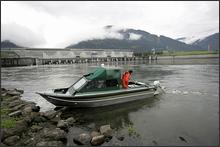forum
library
tutorial
contact

Experts Try to Scare Off
Hungry Sea Lions
by William McCall, Associated Press
Seattle Post-Intelligencer - May 6,, 2005
|
the film forum library tutorial contact |

|
Experts Try to Scare Offby William McCall, Associated Press
|
State asks U.S. to OK plan protecting timber industry against legal action

NORTH BONNEVILLE, Wash. -- Hungry sea lions feasting on chinook salmon at Bonneville Dam were chased off Thursday by harmless underwater firecrackers and noisemaking guns that biologists hope will keep them away for good.
But if the scare tactics fail, the states of Oregon and Washington may have to ask for federal permission to trap or even kill the playful and intelligent marine mammals, which are protected under federal law, just like the salmon.
The sea lions have been feeding near the first dam on the Columbia River for years. But this year only about 100,000 salmon are expected to swim up the fish ladders at the Bonneville Dam on their return journey to spawn, less than half the 250,000 that had been forecast.
Scientists don't know why the spring chinook run is only a fraction of what was expected.
At the rate the sea lions are gobbling up the passing salmon - each eats from 25 to 50 fish a day - biologists are caught between saving salmon and trying to avoid injuring their protected predators.
"This is an especially difficult issue because we have two federally protected species," said Ann Snyder, spokeswoman for the Oregon Department of Fish and Wildlife.
"But whatever we can do to discourage the sea lions from snacking on the salmon, the better," she said.
The states and the Army Corps of Engineers, which operates Columbia River dams, had to get special permission from the NOAA Fisheries and the Coast Guard to run the two-day hazing experiment at Bonneville Dam.
The joint operation Thursday involved dropping 21 "seal bombs," underwater firecrackers that send a mild shock wave that spreads about 20 to 30 feet beneath the surface of the river to scare the sea lions.
The percussion devices do not pose a threat even to smaller animals, such as fish, Snyder said.
"There's no evidence in all their years of use there's been any harm to fish," she said.
A collection of three boats provided by different agencies, including the Oregon State Police, followed the sea lions downriver after the bombardment. Only one or two of the mammals tried to return, and biologists used the noisemaking gun, similar to a flare gun, to chase them away.
Similar hazing attempts have failed against sea lions at Ballard Locks in Seattle after some of the animals proved clever and persistent enough to learn to stay out of range of chase boats and the noisemaking devices.
Indian tribes have already asked Oregon and Washington fishery officials to request federal permission to kill sea lions that prove to be repeat offenders at the dam. Approval could take years, however.
The other alternative is trapping the animals and relocating them, but approval could take from six months to six years under current federal law, Snyder said.
learn more on topics covered in the film
see the video
read the script
learn the songs
discussion forum
